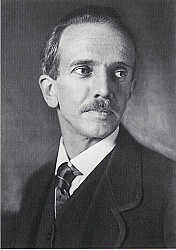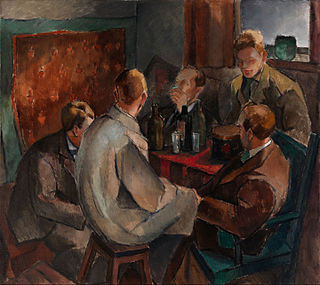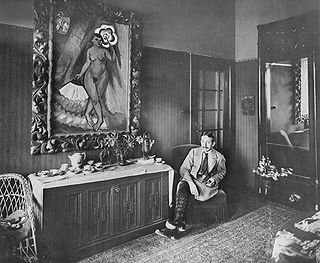The Arbeitsrat für Kunst (German: 'Workers council for art' or 'Art Soviet') was a union of architects, painters, sculptors and art writers, who were based in Berlin from 1918 to 1921. It developed as a response to the Workers and Soldiers councils and was dedicated to the goal of bringing the current developments and tendencies in architecture and art to a broader population.

German is a West Germanic language that is mainly spoken in Central Europe. It is the most widely spoken and official or co-official language in Germany, Austria, Switzerland, South Tyrol (Italy), the German-speaking Community of Belgium, and Liechtenstein. It is also one of the three official languages of Luxembourg and a co-official language in the Opole Voivodeship in Poland. The languages which are most similar to German are the other members of the West Germanic language branch: Afrikaans, Dutch, English, the Frisian languages, Low German/Low Saxon, Luxembourgish, and Yiddish. There are also strong similarities in vocabulary with Danish, Norwegian and Swedish, although those belong to the North Germanic group. German is the second most widely spoken Germanic language, after English.
Contents
The Arbeitsrat worked closely with the Novembergruppe and the Deutscher Werkbund. Some of the architects represented in the Arbeitsrat united in the Glass Chain, or joined the correspondence group, Der Ring. Many members were important founders of the Bauhaus. Individual members informed the most important German academy of art of the time, the Staatliche Akademie für Kunst und Kunstgewerbe Breslau, as well as the Bauhaus.

The Deutscher Werkbund is a German association of artists, architects, designers, and industrialists, established in 1907. The Werkbund became an important element in the development of modern architecture and industrial design, particularly in the later creation of the Bauhaus school of design. Its initial purpose was to establish a partnership of product manufacturers with design professionals to improve the competitiveness of German companies in global markets. The Werkbund was less an artistic movement than a state-sponsored effort to integrate traditional crafts and industrial mass production techniques, to put Germany on a competitive footing with England and the United States. Its motto Vom Sofakissen zum Städtebau indicates its range of interest.
The Glass Chain or Crystal Chain sometimes known as the "Utopian Correspondence" was a chain letter that took place between November 1919 and December 1920. It was a correspondence of architects that formed a basis of expressionist architecture in Germany. It was initiated by Bruno Taut.
Der Ring was an architectural collective founded in 1926 in Berlin. It emerged from expressionist architecture with a functionalist agenda. Der Ring was a group of young architects, formed with the objective of promoting Modernist architecture. It took a position against the prevailing architecture of the time, Historicism. With the rise of National Socialism and the increasing difficulty between Hugo Häring and the other members, Der Ring dissolved in 1933.
In the meantime the German architects whose work follows newly discovered laws of design, have founded a new association. 'The Ring' — a figure of self-contained form without a head — unites a group of like-minded people to pursue their ideals in unison.



















